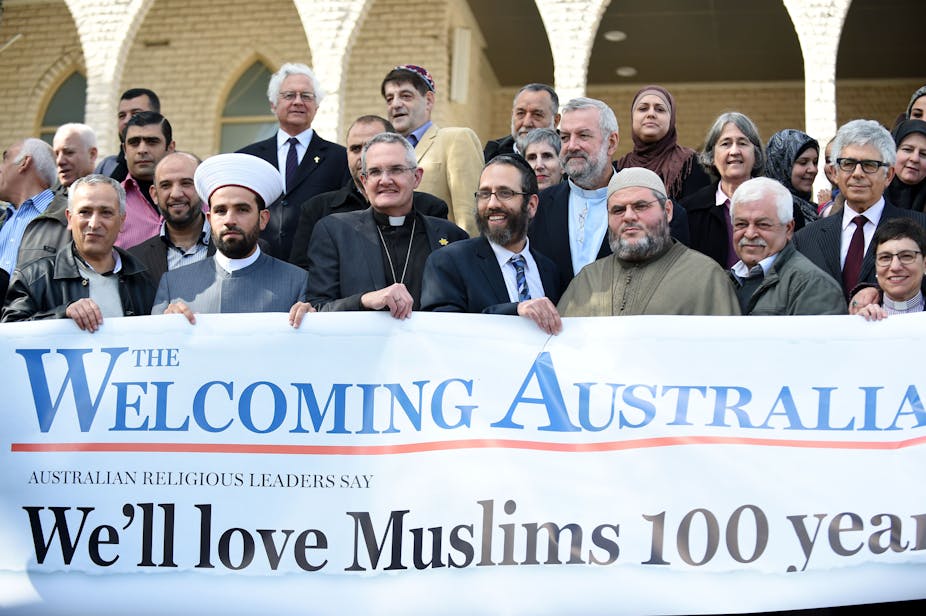Many incidents of violence and harassment directed at Australian Muslims have been reported recently. These are visible confirmation of fears expressed by their community, that support for the government’s new security laws and military action in Iraq would be rallied with “racist caricatures of Muslims as backwards, prone to violence and inherently problematic”.
Policing and intelligence operations have focused exclusively on members of the Muslim community. This has contributed to a public backlash against Muslims and supposed Muslims. The immediacy and scale of this outbreak of Islamophobia is alarming.
Stereotypes do terrible damage
Australia has emerged as a fertile environment for Islamophobia. Stereotypical representations of Muslims in the early years of the “War on Terror” – which linked terrorism, violence and Islam – gained wide currency by the mid-2000s.
Sections of the news media, politicians and social media have re-activated these stereotypes. Muslim Australians are made to feel they are targets - for everything from the everyday racism encountered in schools and on the streets, to draconian counter-terrorism legislation that restricts civil liberties, to war and the preparations for war.
Social psychological research has shown that when public figures and media endorse negative stereotypes this legitimises prejudicial attitudes. This can influence the translation of such attitudes into discriminatory actions, as we have seen in the recent spate of attacks.
Australia now has several openly Islamophobic far-right social movements and political parties. Until recently these were generally small and operated largely in isolation. However, such groups have begun to collaborate on campaigns.
These groups also appear to be attracting more support from the wider community. The re-emergence of anti-Muslim rhetoric in public discourse has provided legitimisation for their views.

Muslims suffer when Coalition dons khaki
The government also appears to be a political beneficiary of the resurgence in Islamophobia. As national security concerns top the news agenda, pressures on the government on a range of other fronts, particularly the deeply unpopular May budget, have faded into the background.
The increased “terror threat” was followed by rises in the approval rating of Prime Minister Tony Abbott and Coalition voting intentions.
The amplification of threats to national security has worked for struggling conservative governments before. In 2001, the Howard government was polling poorly, yet managed to snatch victory later that year. The Coalition election campaign played on racial anxieties and national security fears following the “children overboard” affair and the September 11 terrorist attacks.
In 2010, with the Coalition again languishing in the polls, then opposition immigration spokesman Scott Morrison sought to replicate this strategy. He urged the shadow cabinet to “capitalise on the electorate’s growing concerns about "Muslim immigration” and Muslims’ “inability to integrate”.

The Prime Minister has not been nearly as forthright in condemning acts of Islamophobia as he has been in denouncing Islamic extremists. He even weighed into the debate to dismiss Muslim community concerns. And Abbott failed to condemn the inflammatory push from within his party for a “burqa ban”.
This is in contrast to the firm and admirable stance taken by Western Australian Premier Colin Barnett. He emphasised that “Australia as a country has a history of respecting different cultures and faiths”. The reported taunting and terrorising of Muslim women and children in Perth was “unacceptable”.
Media reports that marginalise harm us all
The media is not blameless either, as some journalists have acknowledged. Australian Muslims have consistently identified the media as a central social institution that contributes to their marginalisation and exclusion.
Media reporting has frequently perpetuated stereotypes. It has also failed to reflect the diversity of origins, outlooks and aspirations of Muslim Australians. Journalism of this sort negatively affects other Australians’ perceptions of Islam and the Muslim community.
My research has shown that articles with lower levels of Islamophobia feature the voices of “ordinary” Muslim men and women. They humanise them. Such articles contextualise conflicts and avoid simplistic frameworks such as “good versus evil” or “War on Terror”.
The media can do more to highlight positive efforts by individuals and groups to resist and respond to oppression and conflict. More balanced perspectives can reduce the reinforcing and perpetuation of Islamophobia.
The “newsworthiness” of stories related to Islam and conflict, and the concentration of negative reporting patterns, suggest that adoption of conflict reporting standards could be another key way to curb Islamophobia.
The mass media and our politicians will be central to either exacerbating or stemming Islamophobia. Gestures of support and solidarity from the non-Muslim community, and standing up to racism, are also important.
Combating Islamophobia is vital to the wellbeing of the Muslim community, to wider community cohesion and to limiting recruitment for groups such as Islamic State (ISIS)/Da’ish. To curb Islamophobia, we must contest the political spectacle that gives rise to discriminatory and violent treatment against Muslims by the state and some non-Muslim Australians.

